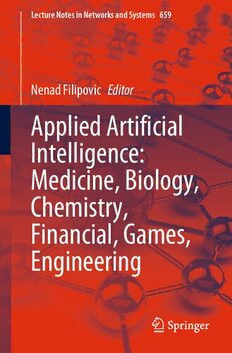
Applied Artificial Intelligence: Medicine, Biology, Chemistry, Financial, Games, Engineering PDF
391 Pages·2023·31.563 MB·English
Most books are stored in the elastic cloud where traffic is expensive. For this reason, we have a limit on daily download.
Preview Applied Artificial Intelligence: Medicine, Biology, Chemistry, Financial, Games, Engineering
Description:
The book is covering knowledge and results in theory, methodology, and applications of Artificial Intelligence and Machine Learning in academia and industry. Nowadays, Artificial Intelligence has been used in every company where intelligence elements are embedded inside sensors, devices, machines, computers and networks. The chapters in this book integrated approach toward global exchange of information on technological advances, scientific innovations, and the effectiveness of various regulatory programs toward AI application in medicine, biology, chemistry, financial, games, law, and engineering. Readers can find AI application in industrial workplace safety, manufacturing systems, medical imaging, biomedical engineering application, different computational paradigm, drug delivery system, and cost-effectiveness analysis. Real examples from academia and industry give beyond state of the art for application of AI and ML in different areas.The computing scene nowadays includes four different computing paradigms and related programming models. Some of the paradigms/models are on the rise, and others are on stable grounds. These 4 paradigms are Control Flow (MultiCores like with Intel and ManyCores like with NVidia), Data Flow (Fixed ASIC-based like with Google TPU and flexible FPA-based like initially with Maxeler DFE and lately with many others), Diffusion Flow (like with IoT, Internet of Things, and WSNs, Wireless Sensor Networks), and Energy Flow (like with BioMolecular and QuantumMechanical computing). For more details, see the references. Each one of the paradigms has different characteristics, as far as (a) Speed, (b) Power, (c) Size, (d) Potential for high precision, and Ease of Programming. Each one of the paradigms is best suited for a given set of problems. Some paradigms are better suited to serve as hosts, others as accelerators. However, they all are best used through a proper type of synergy.Artificial Intelligence leverages sophisticated computation and inference to generate insights, enables the system to reason and learn, and empowers decision making of clinicians. Starting from data (medical images, biomarkers, patients’ data) and using powerful tools such as convolutional neural networks, classification, and regression models etc., it aims at creating personalized models, adapted to each patient, which can be applied in real clinical practice as a decision support system to doctors. This chapter discusses the use of AI in medicine, with an emphasis on the classification of patients with carotid artery disease, evaluation of patient conditions with familiar cardiomyopathy, and COVID-19 models (personalized and epidemiological). The chapter also discusses model integration into a cloud-based platform to deal with model testing without any special software needs.
See more
The list of books you might like
Most books are stored in the elastic cloud where traffic is expensive. For this reason, we have a limit on daily download.
